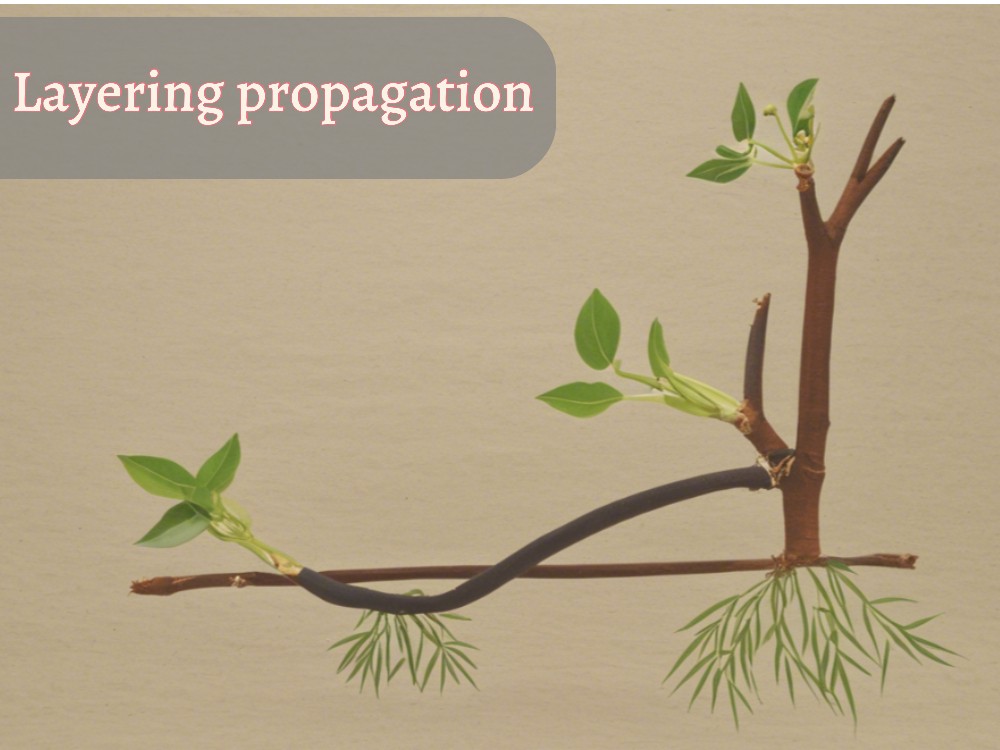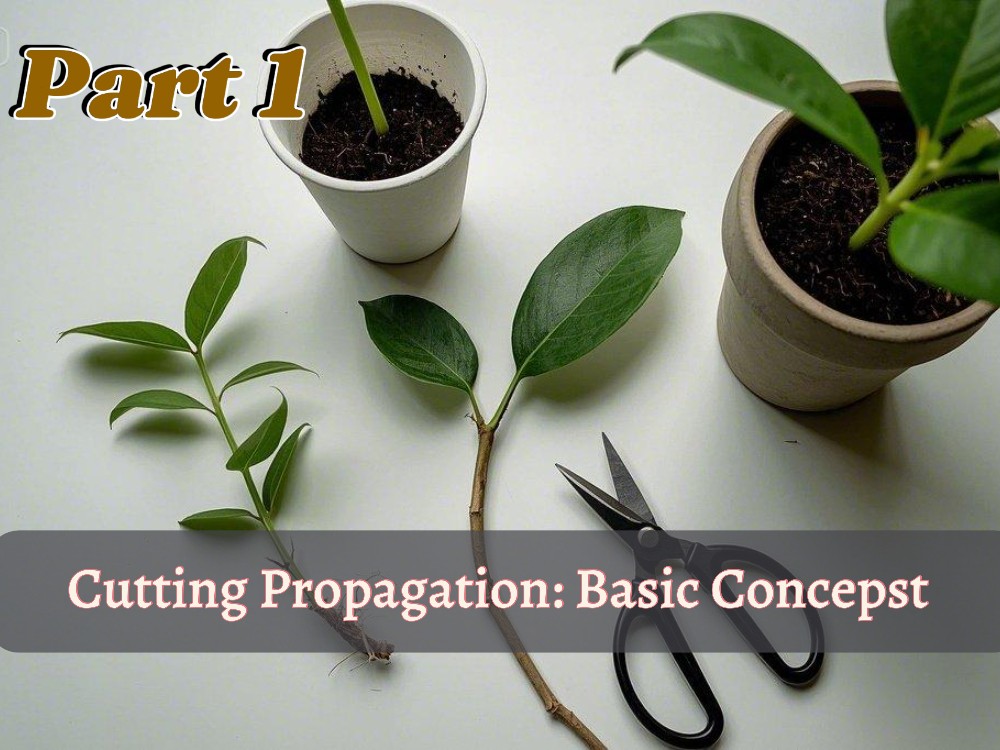Cutting propagation is not alone; its types have a unique and rewarding process. Each plant’s structure, growth requirements, and propagation method are different. Therefore, there are specific cutting types for particular plants.
For example, some plants can be propagated through stem cutting, while some leaves can make new roots, and even some plants’ roots can develop a new plant. On this basis, we found 3 major and popular cutting types. However, some plants, such as Ficus, Sansevieria, and Begonia, can produce roots from all non-reproductive parts (leaf, stem, and roots).
Discover the first part: Cutting propagation, basic concepts!
3 Major Types of Cutting Propagation
1-Stem-Cutting

Stem-cutting propagation means cutting one part of the stem and using it as a new plant by keeping it in the soil or water. In this method, you select stem parts that contain nodes.
Nodes are the stem part where roots and shoots grow.
Each plant has unique hormonal activity in its every growth stage. Stem cutting consists of four types based on the plant’s stem nature and growth hormones;
(a) Softwood cutting
You take a softwood cutting from young, pliable, and green stems. Plants for softwood cutting are fast-growing due to fast growth hormones (Auxins) at both stages; young and mature stems.
These are taken from late spring to early summer when plants are actively growing. Softwood cutting is particularly beneficial for plants that grow moderately and have green, partially mature stems, such as lavender, hydrangea, azalea, and fuchsia. It can’t applied on woody plants due to low hormonal activity in their young stems.
Do you Know? Plants propagated through softwood cuttings are also suitable for hardwood cuttings. These plants grow quickly and vigorously, with high hormonal activity throughout their growth stages, making them ideal for hardwood cutting.
Here’s how to check plant ability for cutting propagation!
(b) Hardwood Cutting
Hardwood cutting succeeds from fully mature, hardened stems. These are typically harvested in late autumn or winter when the plant has gone dormant.
Hardwood cutting is suitable for both types of plants: fast and slow-growing, but the stem should be hardwood, whether it is fast-growing, soft plants or hard, woody plants such as grapes, roses, willow, and fig trees.
(c) Semi-Hardwood Cutting
Some plants are slow-growing, but their stems develop better strength and rooting ability at specific stages when they are not fully mature but not soft. Cutting this not-too-young or not-too-mature stem is called the semi-hardwood method.
The suitable time for semi-hardwood cutting is from late summer to early autumn when the plant’s stem becomes tough but not mature.
(d) Herbaceous Cutting
Some plants exhibit rapid growth cycles, such as herbaceous and non-woody. Their flexibility, softness, and fast growth ability make herbaceous cutting an ideal and natural fit.
It gives effective results in growing seasons like spring or early summer when the plant grows rapidly and healthy with fast hormone production.
(e) Cane Cutting
Although cane cutting is considered the main type of cutting propagation, it is another subtype of stem cutting in which a soft or muscular plant stem is cut into a part to grow a new plant.
Cane cutting is mostly used for cane-like and non-woody plants that store nutrients inside the stem, such as sugarcane, clematis, and bamboo.
Stem cutting timing: The timing of stem cuttings depends on the growth stage because environmental factors directly affect the plant growth. Softwood cuttings are best taken in spring or early summer when the new stems are soft and growing rapidly. Semi-hardwood cuttings are usually taken in late summer and early fall when the stems have hardened somewhat. Hardwood cuttings are taken in winter when the plants are dormant so that the roots can develop in the spring.
2-Leaf cutting

Leaf-cutting involves cutting a healthy plant leaf and keeping it under specific conditions in water or soil to allow root formation and become a new plant. Gardeners use healthy leaves with thick, fleshy, and visible veins in leaf-cutting because they are rich in nutrients that convert into new root growth.
Leaf-cutting types are visible according to the leaf structure, the arrangement of the veins, and their ability to regenerate. Some leaves are formed only at the edges, some along the veins, and some entirely. Based on this concept, here are four main types of leaf-cutting;
(a) Leaf Blade Cutting
Leaf blade cutting is a method in which we cut a whole leaf (without any stem or petiole) to produce a new plant. We keep (upright or laid flat on the soil) a whole leaf directly in the water or growing medium.
New roots start forming after some weeks (about 3 to 4). This method is considered the most effective for Begonia, jade plant, snake plant, and African violet because their leaves have enough growth hormones (e.g., Auxins) to help them form roots and a whole plant.
Each plant leaf’ structure is not the same; some succeed Leaf blade cutting can be divided into two types;
- The whole leaf cutting: Laying the whole leaf on the soil or keeping it in the water without cutting it.
- Sectional leaf cutting: Cutting the large leaves into small sections and pressing them into the soil or keeping them in the water.
Are you confused with leaf sectional cutting? Actually, that happens to me too! So, a sectional cutting is a type of leaf blade cutting where the entire leaf has the potential to grow but is propagated by cutting it into sections. Leaf section cutting is the basic type of leaf-cutting and can sometimes overlap with leaf blade cutting.
(b) Leaf section
The whole leaves of some plants cannot form new roots. So, in some cases, we need to cut a leaf’ section having enough growth hormones to create new roots or plants. We only cut a leaf section instead of the entire leaf.
A specific leaf part (which can form roots) is indeed selected. However, some plants’ leaves can produce roots from different and multiple sections, such as snake plants and Begonia.
But when we consider it as a study, cutting multiple leaf sections (having the ability to form roots) comes in leaf blade sectional cutting, as we have already discussed above.
(c) Leaf Vein Cutting
Leaf vein cutting is a method in which you make small cuts on the central vein (midrib) and sided veins by keeping the leaf underside. Then, we need to place the leaves on moist soil or peat moss and press light so that they can be covered with growing medium.
The roots and small plants begin to emerge from cut veins. This method is mostly applied to plants that have new growth abilities from their leaf’ vines, such as Begonia and African violet. It also can have two subtypes; cross vein and midrib vein cutting, showcasing definition through names.
(d) Leaf Bud Cutting
Some plants propagate effectively; if we add a bud and a tiny stem with a leaf. Because it is this bud that has the potential to form new roots and create a new plant.
The cut part of the leaf, including the bud, is planted in the soil or water so that the bud can grow new branches and roots, and over time, it converts to a whole new plant.
Leaf bud cutting is the best choice for fast-growing plants, such as rose and blackberry, because they already have a bud, which mainly helps to create new roots.
Apart from basic types of leaf-cutting, special leaf-cutting techniques are used for certain plants, such as leaf strip cutting (for snake plants) and leaf with petiole cutting (Begonia, peperomia, and single leaf cutting. These methods are adapted to the natural growth of these plants to succeed in propagation.
Timing for Leaf cutting: Timing for leaf-cutting depends on the leaf structure and the type of plant. In general, leaf cuttings are most successful in spring and early summer, when humidity and temperatures are optimal. Some varieties can also be successful in fall, but spring is the best time for most plants.
3-Root Cutting

Root cutting is also a part of cutting propagation (vegetative propagation)) in which plant roots are cut and kept in water or soil to allow root formation.
Some plants can not propagate through leaf and stem, that’s why root cutting is invented and it is considered an effective way, especially during the dormant season (winter) when the upper part of the plant is not able for other cutting propagation methods.
Still, there are some specific considerations for root cutting, such as roots should be strong, thick (0.25-0.5 inch), and long so that roots can easily create new shoots inside.
This ability has been observed in some perennial and woody plants, such as blackberry, mint, poplar, and phlox.
Here are different types of root cutting based on distinct factors, such as;
(a) Based on the root’s thickness
- Thick root cutting: It is applied to plants that have thick roots.
- Thin root cutting: It is used for plants, that have thin roots.
(b) According to the root part of the structure
- Tip root cutting: It is taken from the tip of the stem and is done on plants with soft, more active, and mostly fast-growing roots, such as Willow.
- Basal root cutting: Taken from the base of the root, which is thicker and harder, and is used in plants that have thick and hard roots, such as Peony.
- Heel root cutting: A small stem part (heel) of the root is also included, which is necessary for certain plants and is done in plants where the root and stem connection is necessary, such as blackberry.
(c) According to the propagation ability of the roots
- Callused root cutting: The root is cut and left for a few days to form a callus (a protective layer), then it is planted in the soil so that new roots can grow.
- Simple root cutting: The root is cut straight and placed in the soil without any preparation so that it can spontaneously form new roots.
- Section root cutting: The root is cut into small pieces, and each piece is planted separately in the soil so that each piece can become a new plant.
Sucker Cutting
Sucker cutting is used on plants that create shoots from their roots and bases, such as bananas, blackberries, flowering plants (roses), and some trees (Alder).
In this method, we cut a sucker from the plant, which consists of nutrients and growth hormones already, making it easy to produce in a short time.
Then, we plant this sucker (6 to 12 inches long and 0.5cm thick) in the soil and provide ideal conditions to grow well. Sucker cutting is mostly done in early spring or summer when it is new and active.
By the way, sucker cutting is alone. However, gardeners make two types based on the plant;
- Root Sucker Cutting: Sucker develops from roots.
- Stem Sucker cutting: Sucker thrives from base (stem).
Finalizing the Part 2: Types of Cutting Propagation
In Part Two of the series, I have given an overview of the types of cutting propagation. However, creating an ideal environment for them and considering other things can be separate, especially for sucker and root cutting. However, you can check out our content about the ideal environment for cutting propagation.
And, I am writing detailed content on each cutting type. Thank you for reading our part 2! If you have any questions or opinions, you can ask freely in the comments or reach us through the Contact Us page.






